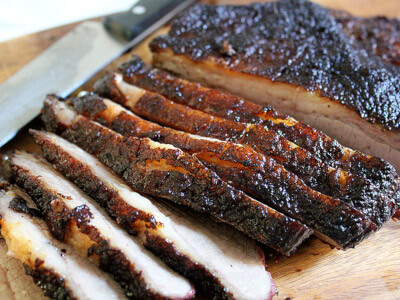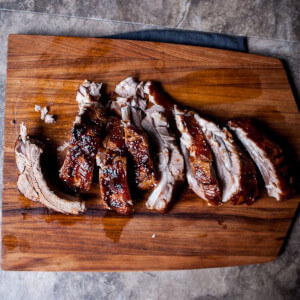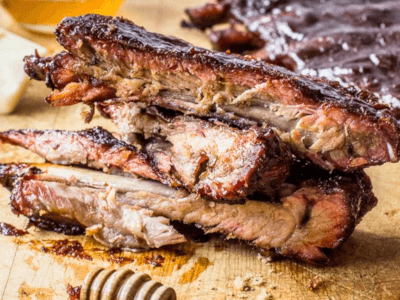 To control the temperatures, you may use water as the meat cooks inside the smoker. Actually, there are water smokers which are specifically designed to be regulated with water.
To control the temperatures, you may use water as the meat cooks inside the smoker. Actually, there are water smokers which are specifically designed to be regulated with water.
But you cannot use water on an electric or gas smoker. The only grills you can incorporate with water are the wood and charcoal smokers. The water is not sprinkled directly but put in a pan and placed inside the smoker.
Then you have a job to refill the pan when it runs out of the water. Wet smoking is an efficient method for big cuts of meat that require longer cooking time.
For the small steaks, that don’t need to be cooked for long, you don’t need to use water to regulate the heat. But before you decide to use wet smoking, you must read the manual that comes with the smoker to ensure that you are not doing anything wrong.
Soak the small chips of wood and leave the large pieces to dry
Suppose you have a small charcoal grill that doesn’t depend entirely on wood for smoking. You can use smaller chips of wood for flavor rather than big pieces.
Wood chips normally burn faster so they run out quickly. To avoid this problem, you should soak them in water so they can last longer. Then, you can wrap the pieces in aluminum foil and perforate holes for the smoke to escape through. But for the larger pieces of wood you need for a wood pellet grill, make sure they are completely dry.
Get your smoker ready
Every grill comes with different specifications which are found in the user’s manual. Read carefully the instructions on how to get your smoker ready. When using charcoal or wood, light the fuel and let it burn completely until the flames disappear. Never place brisket fat directly over the heat.
Instead, push aside the fuel/coal to allow for slow cooking with indirect heat. You will be adding more woods or coal as needed to keep your grill running. Aim at maintaining a temperature range of between 93⁰C and 104⁰C throughout the cooking process. Things will be much easier if you have an electric or gas grill.
All you have to do is set the temperature and turn on the grill while taking into account the manufacturer’s instructions. Always put your wood where it should be and don’t forget to use the manual. If you have a wood or charcoal grill, it would be a great idea to invest in a thermometer to help you regulate temperatures more accurately.
Prepare your meat
At this point, you should already have in mind the type of meat you want to smoke in your fire smoker grill. The most interesting thing about smoking is that it applies to all sorts of meat. However, it does well on tough cuts that require long hours of slow cooking.
This process disintegrates connective tissues and fatty muscles, leaving your meat as tender as a bud. It is important to choose a meat that tastes nice when paired with a smoky flavor. Check out examples of meat that are extremely delicious when smoked.
- Fish: Tilapia, salmon, lobster, trout.
- Poultry: Chicken drumstick and turkey.
- Pork: Pork spare ribs, ham, pork crown roast.
- Beef: corned beef and brisket.
Brine the meat with a meat rub or marinade
Brine is a common ingredient for most meats. Brine and rub serve the same purpose. These treatments hydrate and improve the meat flavor before it is cooked. The smoke will definitely affect the flavor so these ingredients are not very necessary. But if you want to enjoy the deepest flavor, mix the brine recipe and coat entire brisket or ham in the marinade.
Leave it overnight in the fridge to brine. The marinade is often used in most beef cuts and briskets. To allow the marinade to soak properly, score your meat in several places for deep penetration.
Before you start cooking, get your meat out of the fridge and drain it so it comes to room temperature. To treat the ribs, use meat rubs. These are basically a combination of spices like black pepper coriander, and salt. Apply the rub over the entire meat and leave it for a few minutes.
Allow the meat to reach room temperature
Do not start smoking any meat immediately after removing it from the fridge. You must allow it to come to room temperature to ensure even cooking.
At the end of the cooking process, you want the whole brisket to have a consistent internal temperature. Make sure that the meat stays on the kitchen counter for about 2 hours before it is placed on the backyard grill.
Smoke your meat
First, determine how long your brisket should take to cook. There are various factors that dictate how long it takes the meat to cook completely: type of meat, the heat of the grill, and meat size.
Generally, six to eight hours or a little more should be enough for beef and pork. A big brisket could take 22 hours! Again, confirm from your recipe the time needed to smoke your meat so you can plan accordingly.
Put the meat in the smoker
You can smoke place brisket indirectly using a shallow aluminum plate (never use aluminum foil) or directly on the smoker. Wrapping it in aluminum foil prevents the smoky flavor from penetrating your meat.
You want the smoke to touch your whole brisket around throughout the grilling process. Depending on what you are cooking, you may change the position of the meat.
For smoked brisket, put it side-down and keep the brisket fat side up. But the meat must not be placed over direct heat. As stated earlier on, when using a charcoal grill, scoot the coals sideways so that the meat is not cooked too quickly, something that can burn it up.
Baste your meat (optional)
This technique is not a must and it depends on the type of meat you have at hand. Basting keeps your meat moisturized throughout the smoking process.
It is a popular option for ribs and briskets. Before you baste anything, read your recipe carefully to find if it is necessary. Note that as long as you are smoking your meat slowly at low temperature, it will definitely come out tender and moisturized.
So, basting will not have a significant effect. To baste your meat, mop it with a solution of water, vinegar, salt black pepper, and other spices. Use a barbecue mop to do so.
Cover your meat
The smoking process uses a 3-2-1 recipe. For the first 3 hours, allow the meat to smoke so the flavors can be infused. Then, in the next 2 hours, cover it with a foil so it can warm up internally.
Finally, uncover the meat in the last 1 hour to let it gain a thick crust. But you must confirm from your recipe the exact point the meat needs to be uncovered.
Remove your meat from the smoker
Congratulations, if you have come this far! When your meat reaches the recommended temperature level, remove it from the grill.
You will require a thermometer to improve your result and determine how thorough your meat has been cooked. All ground meat and pork must reach 160⁰F while smokes poultry should be 165⁰F. For the steaks, chops, and roasts, ensure that they hit 145⁰F.
Confirm the smoke ring
A pink ring normally forms just below the mouthwatering outer crust. It can be attributed to the reaction that occurs when smoke infiltrates into the steak. The color is basically a collection of nitric acid.
This is a sign of excellent barbecue. It is no wonder that BBQ adjudicators check for the pink badge of honor when judging competitors. What happens is that the burnt wood produces nitrogen dioxide which dissolved into the wet meat and binds with myoglobin, a protein that is responsible for the red color of meat.
Final step about smoking meat
When you are done, don’t serve your brisket dry. Get a sauce to glaze the meat and place it on the grill for about 15 minutes.
The sauce will bake into the brisket and your work will be done. Then gather a bunch of hungry people and start digging in!

 First, determine what you’ll be using. Basically, you need suitable equipment for smoking and not just a hole in the soil stacked with firewood.
First, determine what you’ll be using. Basically, you need suitable equipment for smoking and not just a hole in the soil stacked with firewood. There are various hardwoods you can use to smoke meat. Different woods have different flavors with some being stronger than others. Yet we have some wood that auger well with particular meat types.
There are various hardwoods you can use to smoke meat. Different woods have different flavors with some being stronger than others. Yet we have some wood that auger well with particular meat types. To control the temperatures, you may use water as the meat cooks inside the smoker. Actually, there are water smokers which are specifically designed to be regulated with water.
To control the temperatures, you may use water as the meat cooks inside the smoker. Actually, there are water smokers which are specifically designed to be regulated with water.